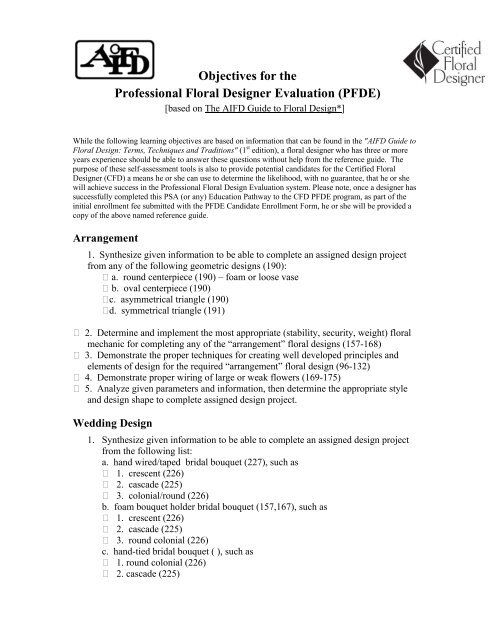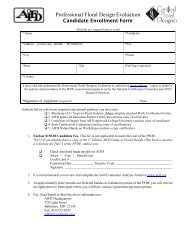PFDE Hands-on Evaluation Objectives - AIFD
PFDE Hands-on Evaluation Objectives - AIFD
PFDE Hands-on Evaluation Objectives - AIFD
You also want an ePaper? Increase the reach of your titles
YUMPU automatically turns print PDFs into web optimized ePapers that Google loves.
<strong>Objectives</strong> for the<br />
Professi<strong>on</strong>al Floral Designer Evaluati<strong>on</strong> (<str<strong>on</strong>g>PFDE</str<strong>on</strong>g>)<br />
[based <strong>on</strong> The <strong>AIFD</strong> Guide to Floral Design*]<br />
While the following learning objectives are based <strong>on</strong> informati<strong>on</strong> that can be found in the "<strong>AIFD</strong> Guide to<br />
Floral Design: Terms, Techniques and Traditi<strong>on</strong>s" (1 st editi<strong>on</strong>), a floral designer who has three or more<br />
years experience should be able to answer these questi<strong>on</strong>s without help from the reference guide. The<br />
purpose of these self-assessment tools is also to provide potential candidates for the Certified Floral<br />
Designer (CFD) a means he or she can use to determine the likelihood, with no guarantee, that he or she<br />
will achieve success in the Professi<strong>on</strong>al Floral Design Evaluati<strong>on</strong> system. Please note, <strong>on</strong>ce a designer has<br />
successfully completed this PSA (or any) Educati<strong>on</strong> Pathway to the CFD <str<strong>on</strong>g>PFDE</str<strong>on</strong>g> program, as part of the<br />
initial enrollment fee submitted with the <str<strong>on</strong>g>PFDE</str<strong>on</strong>g> Candidate Enrollment Form, he or she will be provided a<br />
copy of the above named reference guide.<br />
Arrangement<br />
1. Synthesize given informati<strong>on</strong> to be able to complete an assigned design project<br />
from any of the following geometric designs (190):<br />
a. round centerpiece (190) – foam or loose vase<br />
b. oval centerpiece (190)<br />
c. asymmetrical triangle (190)<br />
d. symmetrical triangle (191)<br />
2. Determine and implement the most appropriate (stability, security, weight) floral<br />
mechanic for completing any of the “arrangement” floral designs (157-168)<br />
3. Dem<strong>on</strong>strate the proper techniques for creating well developed principles and<br />
elements of design for the required “arrangement” floral design (96-132)<br />
4. Dem<strong>on</strong>strate proper wiring of large or weak flowers (169-175)<br />
5. Analyze given parameters and informati<strong>on</strong>, then determine the appropriate style<br />
and design shape to complete assigned design project.<br />
Wedding Design<br />
1. Synthesize given informati<strong>on</strong> to be able to complete an assigned design project<br />
from the following list:<br />
a. hand wired/taped bridal bouquet (227), such as<br />
1. crescent (226)<br />
2. cascade (225)<br />
3. col<strong>on</strong>ial/round (226)<br />
b. foam bouquet holder bridal bouquet (157,167), such as<br />
1. crescent (226)<br />
2. cascade (225)<br />
3. round col<strong>on</strong>ial (226)<br />
c. hand-tied bridal bouquet ( ), such as<br />
1. round col<strong>on</strong>ial (226)<br />
2. cascade (225)
2. Dem<strong>on</strong>strate proper wiring techniques for given flowers – such as clutch wiring,<br />
cross-pierce wiring, hairpin wiring, and inserti<strong>on</strong> wiring (page 169-175)<br />
3. Dem<strong>on</strong>strate proper anchoring of cascading or heavy flowers – i.e. stem<br />
adhesive (164) or other methods<br />
4. Dem<strong>on</strong>strate the proper techniques for creating well developed principles and<br />
elements of design for the different shapes, forms, and styles of wedding design<br />
(96-132)<br />
5. Analyze given parameters and informati<strong>on</strong>, then determine the appropriate style<br />
and design shape to complete assigned design project.<br />
Funeral Tribute<br />
1. Synthesize given informati<strong>on</strong> to be able to complete an assigned design project<br />
from any of the following geometric designs (190):<br />
a. traditi<strong>on</strong>al (307) styled casket spray (200)<br />
b. diag<strong>on</strong>al (191) casket spray (200)<br />
c. easel (201) wreath design (206)<br />
e. standing easel spray (205)<br />
f. basket design (198, 343, 347)<br />
2. Analyze given parameters and informati<strong>on</strong>, then determine the appropriate style<br />
and design shape to complete assigned design project.<br />
Duplicati<strong>on</strong> Design<br />
1. Synthesize given parameters and informati<strong>on</strong> to be able to complete the<br />
“duplicati<strong>on</strong>” design using the following guidelines:<br />
a. Copy the provided image as closely as possible with the materials<br />
provided,<br />
i.e. same flowers, foliage, shape, style, c<strong>on</strong>tainer, etc.<br />
b. If exact flowers/foliage are not provided, the evaluati<strong>on</strong> candidate must<br />
choose the<br />
most appropriate substituti<strong>on</strong>s.<br />
2. Dem<strong>on</strong>strate the proper techniques for creating well developed principles and<br />
elements of design for the duplicati<strong>on</strong> design (page 96-132)<br />
Flowers to Wear<br />
1. Synthesize given informati<strong>on</strong> to be able to complete an assigned design project<br />
from the following list:<br />
a. corsage (223) for, shoulder, hair, or special request<br />
b. single and double bout<strong>on</strong>nieres (222)<br />
c. circlet (222) or floral wreath headpiece (223)
d. wristlet (224)<br />
e. floral jewelry (223)<br />
2. Dem<strong>on</strong>strate the proper techniques for creating well developed principles and<br />
elements of design for the flowers to wear design (96-132)<br />
3. Dem<strong>on</strong>strate proper wiring techniques for given flowers – such as clutch<br />
wiring, cross-pierce wiring, hairpin wiring, and inserti<strong>on</strong> wiring (169-175)<br />
4. Analyze given parameters and informati<strong>on</strong>, then determine the appropriate style<br />
and design shape to complete assigned design project.






